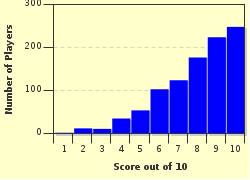Quiz Answer Key and Fun Facts
1. On Friday, November 22, 1963, police patrolman J. D. Tippitt was shot and killed while questioning a possible crime suspect, while standing near his marked police vehicle. His suspected killer was arrested for the crime, but was never tried or convicted for the crime in a court of law. Who allegedly shot Officer J. D. Tippitt?
2. John Lennon, one of the world's most famous musical talents, was shot and killed as he returned to his residence in New York, after completing a recording session. Which deranged fan was arrested at the scene for the murder of Lennon?
3. One of the founding fathers of the United States of America, the first U.S. Secretary of the Treasury, Alexander Hamilton, died as a result of a gunshot wound on July 12, 1804. Who fired the bullet that ended the life of Alexander Hamilton?
4. The 25th President of the USA, William McKinley, was shot at point blank range by a gunman as he greeted guests at the Pan-American Exhibition in Buffalo, New York, on September 5, 1901. Who was convicted of the shooting murder of McKinley?
5. On Sunday morning, November 24, 1963, during a live television broadcast, Lee Harvey Oswald, the accused assassin of President John F. Kennedy, was himself shot and killed in the basement of Dallas Police Department Headquarters, while he was being transferred (in handcuffs) to a more secure holding facility. Who was shown on television as he shot Oswald at point blank range, to the shock of dozens of police and press officials present for the event?
6. Chicago Mayor Anton J. Cermak was shot and killed during an assassination attempt on the life of U.S. President-Elect Franklin D. Roosevelt in Miami, Florida. Who was tried and convicted for the murder of Cermak?
7. Many feel that the bright lights of the future of the United States were dimmed on June 5, 1968 with the assassination of U.S. Senator, and presidential hopeful Robert F. Kennedy. The accused gunman was immediately captured at the scene in Los Angeles, California. Who was convicted and sent to prison for committing the crime?
8. While campaigning for the office of President of the United States, Democratic candidate George Wallace was shot in Laurel, Maryland on May 15, 1972. Who fired the bullets that critically wounded George Wallace?
9. Residents of the city of San Francisco, California were shocked on November 27, 1978 to learn of a shooting at their City Hall that claimed the lives of the city mayor, and a member of the city's Board of Supervisors. Who was responsible for committing these heinous murders?
10. An assassination attempt was made on the life of Ronald Wilson Reagan, the 40th President of the United States, as he left a Washington D.C hotel on March 30, 1981. Who was the deranged gunman who critically wounded Reagan and three other men on that fateful day?
Source: Author
MaceoMack
This quiz was reviewed by FunTrivia editor
bloomsby before going online.
Any errors found in FunTrivia content are routinely corrected through our feedback system.

